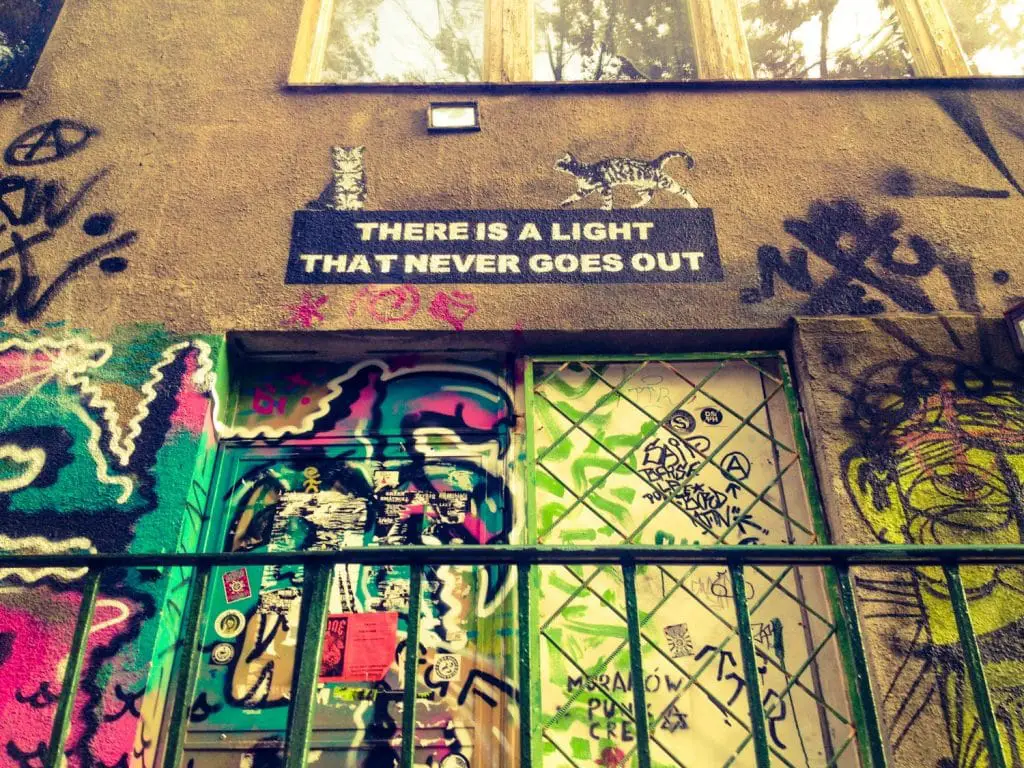Street art is a controversial issue. Legally, it can be considered vandalism and, to some, creates the impression that the area is unloved and untended. Regardless of personal opinions on legality, the line between graffiti and art is subjective and arbitrary. From humble beginnings of tagging in the United States to Banksy’s recent Dismaland bemusement park, street art has evolved with modern technology while retaining its inherent political roots. Checking out the Poles’ underground movements from the World War II to present day through their choice of graffiti offers some intriguing insights and places to visit.
Backdrop for Early Taggers
The birth of modern graffiti is officially credited to Cornbread and Cool Earl (Philadelphia) in the early sixties, but it really took off a few years later in New York City. NYC saw graffiti gaining popularity in the late sixties due to a New York Times feature on the graffiti artist TAKI 183. Ivor L. Miller, author of Aerosol Kingdom: Subway Painters of New York City, said of the graffiti movement that it began “as a younger generation’s artistic response to the public protests of the Black Power and civil-rights movements.” Subway and suburban trains were the main canvases for these writers; the appeal of their tag traveling the city gaining notoriety generated massive works covering entire train cars. Mayor John Lindsay declared a city-wide war on graffiti in 1972, which has remained til today, costing the city over hundreds of millions of dollars. Graffiti persisted as the art of choice for the NYC youth, and the ’80s set the stage for the graffiti-hip hop collaboration.

What’s the Kotwica Got to Do With It?
Decades before modern graffiti got its start, young boy scouts in Warsaw took up paint brushes and covertly drew the now-legendary P and W, the Kotwica (“Anchor”). It was the primary symbol of the Polish underground movement under the Nazi’s, the Armia Krajowa (“Home Army”), and later used by anti-communist groups under Soviet rule. It was created by Anna Smolenska in early 1942, originally signifying Pomścimy Wawer, or “We shall avenge Wawer,” the 1939 massacre of Polish civilians by Nazi troops. Eventually, the Kotwica came to represent Polska Walcząca, or “Fighting Poland.” Specifically in Warsaw, the anchor symbol also represented Wojsko Polskie (“Polish Army”) and Powstanie Warszawskie (“Warsaw Uprising”). From being stamped on German propaganda papers in Warsaw to painted on walls and monuments, the Kotwica became the symbol of resistance movements around the country.

On the Streets During the Soviet Era
Poland’s communist authorities actually banned the Kotwica after World War II, but it wasn’t forgotten. Graffiti during the Soviet years was highly punishable, although popular tags in public included peace signs, sport team logos, and rock-and-roll references (check it out here). While in America, graffiti became synonymous with hip-hop, the Soviet public correlated graffiti with rock music. Near the end of the era with Gorbachev’s glasnost, the Kotwica restrictions lightened and many anti-communist organizations in Poland took up the renowned symbol.
While posters may not immediately come to mind when thinking about graffiti, street art posters have contributed to the visibility of many underground movements. In 1961, the Poster Section of the Gallery of Contemporary Art was created after moving the collection of posters out of the National Museum. The Poster Gallery was then opened in June 1968 near Wilanów and hosts an annual International Poster Biennale (check them out here).
Modern Graffiti and Street Art in Poland
After the heavy and bland grey Soviet architecture, colorful works began springing up around the state following the collapse. While there will always be some undecipherable tags scribbled around the city, there is has been a torrent of massive art works adorning previously-drab building sides. Now, Polish cities like Łódź, Wrocław, Warsaw, and Katowice have been making international acclaim in the street art circles. From festivals to community programs, urban art has been on the rise. In 2008, curators from the Galeria Awangarda in Wrocław organized Poland’s first street art exhibition, “Out of Sth.” There have been numerous exhibitions since, but only a few annual events.
Festivals to check out:
Katowice Street Art Festival
Galeria Urban Forms Festival in Łódź
From the Kotwica to “Bigger than Banksy,” Poland has street artists with the style to entice appreciation rather than antagonize local authorities. When I lived in Warsaw, I was impressed by the amount of murals even in Old Town. Coming from outside of Philadelphia, that’s saying something. Some complain that Warsaw isn’t as architecturally-stimulating as other Polish cities, but if you’re looking for urban art, you won’t be disappointed. You don’t have to wait until the festivals; you’re likely to stumble upon a work of wall art while on your way to find some good coffee (on that note: I suggest Relax, Secret Life, or Roslina cafe). Take a minute for appreciation, and good luck exploring!
Links of note:
Etam Cru’s website
Warsaw street art fanpage
Wiki category of photos about the Kotwica








